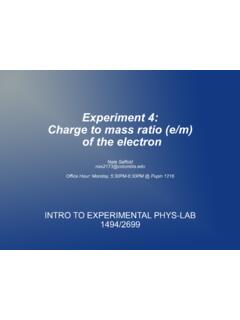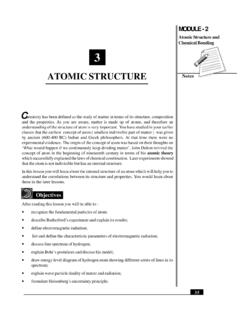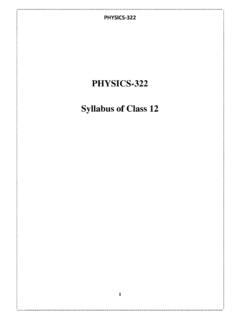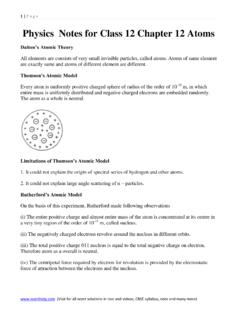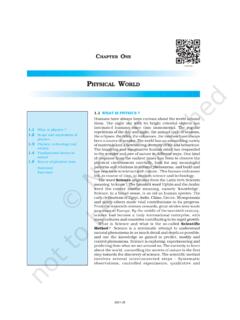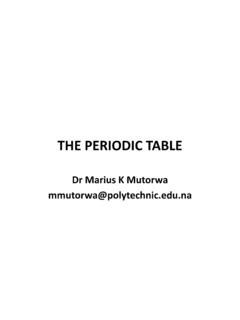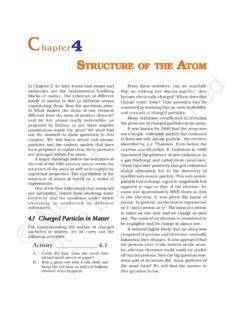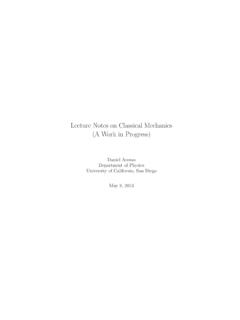Transcription of The Nature of Science - ed
1 The Science Education Review, 1(2), 2002 43 Source Folino, D. A. (2001). Stories and anecdotes in the chemistry classroom. Journal of Chemical Education, 78, 1615- 1618. The Nature of Science Introduction Science is often referred to, particularly in curriculum documents, as one way of knowing, one way of describing, classifying, and understanding our universe. For students to become scientifically literate, they need to engage in the discourses .. about Science (Eastwell, 2002), so developing an understanding of the Nature of Science (NOS), including both its strengths and limitations, is an integral component in a Science for All curriculum. It is also a commonly neglected one. However, there are also other ways of knowing, other ways of understanding our universe. These include aesthetic, interpersonal, intuitive, narrative, formal, and practical modes of knowing. Only by being aware of at least the broad characteristics of these various ways of knowing are we in a position to appreciate the role of scientific knowing within the broader perspective, and some distinguishing features of these other modes of knowing will be discussed in future issues of SER.
2 NOS might be defined as the values and assumptions inherent to Science (Lederman, 1992, p. 331). This article will identify and discuss these values and assumptions, address some misconceptions associated with them, and make some pedagogical recommendations. Other sections of SER will offer related student activities. First, though, allow me to make two introductory remarks. In broad terms, the discipline of Science is characterised by its central commitment to evidence as the basis of justified belief about material causes and the rational means of resolving controversy (Siegel, 1989). Science is also progressive and universal (Good & Shymansky, 2001). However, at the level of fine detail, scientists, philosophers, and Science educators differ in their opinions about NOS (Fourez, 1989; Lederman, 1986; Meichtry, 1993). For the purposes of school Science , though, considerations at this level of sophistication are not necessary and would, in fact, be inappropriate (Abd-El-Khalick & Boujaoude, 1997).
3 This article adopts such a pragmatic approach. Second, some features of NOS, such as creativity and the presence of competing explanations/theories, are also features of other ways of knowing. The following features of NOS are therefore presented in two parts, as described by Smith and Scharmann (1999). The first part contains distinguishing features of NOS, those The Science Education Review, 1(2), 2002 44 features which tend to make a question or field of study more scientific rather than less scientific. The second part gives important non-distinguishing features of NOS. The listing is a modified composite of items from Niaz (2001), McComas, Clough, and Almazroa (1998), Moss, Abrams, and Robb (2001), Smith and Scharmann (1999), and Taylor and Fraser ( ). Features of the Nature of Science Distinguishing features: 1. Scientific knowledge demands empirical evidence ( , Science is derived from, and guided by, observation or experiment.)
4 2. Scientific claims are testable/falsifiable. Popper (1968) suggested that only ideas that are potentially falsifiable are scientific ideas. Hence, a term like creation Science is an oxymoron, because the notion that fully-formed species were placed on Earth by some supernatural force is a religious belief and not part of the scientific paradigm, because it cannot be tested/falsified. 3. Scientific tests or observations are repeatable. 4. Scientific knowledge is tentative and developmental, and hence fallible. While this statement is true, in an overall sense, it does hide much detail and is consequently potentially misleading. There are different degrees of tentativeness associated with different types of scientific knowledge. We are, for example, rather certain about Boyle s law, that copper is a good conductor of electricity, and that the Earth is round rather than flat, but far less certain about the origins of modern man, that an asteroid caused mass distinction of the dinosaurs, or that there is no life on Mars.
5 I am quite sure that people who travel in aeroplanes, drive over suspension bridges, or take medicines appreciate that some scientific knowledge is quite reliable! 5. Science is self-correcting. Non-distinguishing features: 6. Scientific progress is characterised by the invention of, and competition among, hypotheses/theories. Wegener s suggestion that the continents had once been one, and drifted apart, was regarded at the time as almost lunatic. Groups led by rutherford and Thompson obtained very similar results for the scattering of alpha particles by materials, yet they bitterly disputed the two different models (nuclear and plum pudding, respectively) that they proposed for the structure of The Science Education Review, 1(2), 2002 45 the atom, to the extent that rutherford accused a colleague of Thomson with having fudged data to support Thompson s model. 7. Different scientists can sense the same things, and interpret the same experimental data, differently.
6 There have been countless cases of scientists having either not seen certain things or, based on their expectations, deeming what they did see to be unimportant, leading to the conclusion that observations are theory-laden. Holton s (cited in Niaz & Rodr guez, 2002) examination of Millikan s handwritten notebooks revealed that, in preparing the crucial paper, Millikan had discarded the results for 59% of oil drops because they did not support his hypothesis of the elementary charge. Ehrenhaft, on the other hand, obtained very similar experimental results and postulated fractional electronic charges. 8. Science cannot provide complete answers to all questions/problems. This is true, but at the same time Science does answer many questions very well indeed. Science cannot, though, answer moral, ethical, aesthetic, social, and metaphysical questions, although it may provide some useful insights.
7 It is inappropriate, for example, to ask Science to determine whether or not abortion is acceptable. 9. Science is a social activity, both influencing society and being influenced by people s values and opinions. Personalities, funding, social movements, public opinion, the media, politicians, and others drive Science . 10. Logic, imagination, curiosity, and serendipity contribute to scientific exploration. Some Myths Let us now discuss four myths, four widely held yet incorrect ideas about NOS. These misconceptions are perhaps due to a combination of the way terminology is used by leaders and others in our communities, the lack of NOS content and real Science research experiences in teacher education, and the shallow treatment of NOS, the omissions of key aspects of NOS, and the explicit inclusion of faulty ideas about NOS, in school textbooks. Myth 1: A universal scientific method exists.
8 This myth probably stems from the series of sequential steps, commonly termed the scientific method, which appear in many school texts, and may also be reinforced by the standardised format used to present articles in Science journals. The steps vary from text to text, but the following are typical: observing, forming a hypothesis, testing the hypothesis, reaching a conclusion/s, and reporting the work. The Science Education Review, 1(2), 2002 46 Rather than working to a standard research plan, scientists use a multiplicity of ways to obtain and organise knowledge, including intuition and chance. Newer texts are adopting the approach of discussing the methods of Science , rather than any particular scientific method alone, and this will assist in overcoming this myth. At the same time, though, the above steps do appear in the history of most scientific work, even if their order is found to vary.
9 Myth 2: A hypothesis is an educated guess. The following explains some terms associated with the progress of Science (Baxter & Kurtz, 2001; Eastwell, 1996): Law (or rule or principle) a generalised statement which summarises the observed regularities or patterns in Nature ( Charles law and Archimedes principle). Hypothesis a possible explanation for the observed facts and laws ( Bohr s hypothesis). Theory an explanation, which has stood the test of time and in which we therefore show much faith ( the kinetic theory of gases and the atomic theory). A theory may be a broad explanation derived from the convergence of many hypotheses. Model a mental picture of, or analogy for, the phenomenon, involving a system which is well understood and which appears to behave in a similar manner to the system under consideration ( the particle model of a gas). Test hypothesis (or test theory) accomplished by determining whether or not the hypothesis, or theory, is in accord with new experimental evidence.
10 Experiments are purposely designed to test a prediction of a hypothesis or theory. The new experimental evidence is said to either support or refute the hypothesis or theory. If refuted, the hypothesis or theory may be either modified or abandoned completely. A hypothesis or theory can never be proven absolutely correct, because subsequent evidence could always refute it. Returning to Myth 2, when school students are asked to propose a hypothesis during experimental work, they are really most often being asked for a prediction, which is different. A prediction is an educated guess about the expected outcome of a test and is likely to be factual, and most predictions can be evaluated by observation. Hypotheses, on the other hand, are possible reasons/explanations for the observations, being stated in a manner that makes them amenable to testing and falsification. Virtually all contemporary biological research also incorrectly claims to test hypotheses, when in fact the research describes patterns rather than testing mechanisms underlying the patterns (McPherson, 2001).










